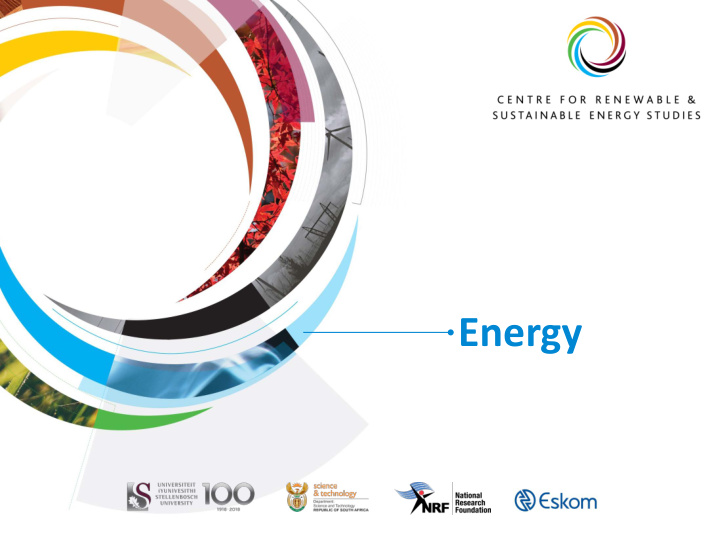



Energy
What is Energy What is Energy? • Energy can be defined as the capacity to do work. • Energy is all around us. • We can see light energy from the sun. • Energy cannot be created or destroyed ; it can only be transformed from one form to another. • Heat energy from the sun keeps us warm. • We can see the kinetic energy of the wind that causes a door to slam. • The chemical energy stored in food sustains life. • Energy is needed to make cars move. • Without energy, the world would be cold and dark. 2
Renewable vs Non-renewable Renewable vs Non-renewable: Renewable Energy Sources • We use energy from both renewable and non- renewable sources every day. • Renewable energy comes from natural energy sources that replenish themselves continually. • The sun is the main source of energy . There are two sources of renewable energy that are not dependent on the sun: Geothermal and Tidal energy. • Most of the following renewable energy sources have a limited negative environmental impact: – Sun – Wind – Water – Biomass – Geothermal sources – Ocean 3
Renewable vs Non-renewable Renewable vs Non-renewable: World’s Energy Sources • Energy drives modern society. • Currently most of the world’s energy is derived from non-renewable sources. • There is a global need to increase the use of renewable energy sources and decrease the use of non-renewable energy sources , thus reducing environmental pollution. 4
Renewable vs Non-renewable Renewable vs Non-renewable: Non-renewable Energy Sources • Fossil fuels are hydrocarbon compounds in the crust of the earth that have developed from decomposed plant and animal matter over millions of years. • Fossil fuels are called non-renewable energy sources because they cannot be replenished. • Fossil fuels contain chemical potential energy which is released through combustion. • Combustion is the most common way of converting the chemical potential energy in fossil fuels into kinetic energy (work). • Oil, coal and gas are fossil fuels and are non- renewable. • Burning fossil fuels releases greenhouse gases . • An increase in greenhouse gases has significant environmental impacts. 5
Renewable vs Non-renewable Renewable vs Non-renewable: The Hot Issue • Modern society is totally dependent upon energy in the form of electricity derived from burning fossil fuels ,and energy derived from combustion engines burning fossil fuels. • Combustion engines are used by cars, trucks, planes, generators, etc. • Burning fossil fuels releases a gas called CO 2 (carbon dioxide) which increases the greenhouse effect . • Carbon is the basic building block of all fossil fuels. When fossil fuels are used, the carbon reacts with the oxygen in the atmosphere to form carbon dioxide , which is then released into the atmosphere. • This depletes the oxygen levels in the atmosphere. 6
Environmental Impact The Environmental Impact: The Greenhouse Effect • The greenhouse effect is a warming of Earth's surface and the air above it, called the atmosphere. • Without the natural greenhouse effect, the earth’s temperature would be on average -18 o C instead of the 15 o C it is now. • It is caused by gases in the air that trap energy from the sun. • These heat-trapping gases are called greenhouse gases. • The most common greenhouse gases are water vapour (H 2 O g) , carbon dioxide (CO 2 g ), methane (CH 4 g ) and other gases. • By burning fossil fuels in such vast quantities, we have increased the levels of CO 2 and other greenhouse gases in the atmosphere, thus trapping more of the sun’s heat and raising global temperatures. This is known as global warming. 7
Environmental Impact The Environmental Impact: Outcomes of Global Warming There are a number of negative effects caused by global warming: • Global warming is thus a rise in the average temperature of the earth’s atmosphere which is causing climate changes. • Rising sea and air temperatures are slowly melting the ice in the Arctic and Antarctic oceans. This has very big effect on raising sea levels. • This is because as the earth’s average temperature rises due to global warming, the temperature of the sea also rises . When the temperature of water rises, melting of the ice in the polar regions increases so there is an increase in sea water volume, which in turn causes sea levels to rise. • Climate change can be experienced through increased droughts, heavier snow storms and an increase in floods. • This will have far-reaching effects on us, our food supply and the whole natural world. • Using renewable energy would mean that less CO 2 would be released, thus reduce the impact of global warming. 8
SA Energy Resource South African Total Energy Resource in 2018 Source: www.energy.gov.za/IRP 9 9
References Slide 2: https://www.pexels.com/photo/sun-fire-hot-research (Sun), www.pexels.com/photo/person-holding-green-leafed-plant (green leaf), https://www.pexels.com/photo/alternative-auto-automobile-battery (Electric car), www.pexels.com/photo/car-refill- transportation-gas (Car refill) Slide 3: www.pexels.com/photo/gray-steel-gas-tanks-near-white-steel-wall-during-daytime (Gas tanks), www.pexels.com/photo/black-close-up-coal-dark (Coal), www.pexels.com/photo/low-angle-view-of-illuminated-tower-against-sky- at-night (Gas burning). Slide 4: https://www.pexels.com/photo/abstract-beach-bright-clouds (Sun), https://www.pexels.com/photo/nature-forest-waves- trees (Running water), www.pexels.com/photo/boiling-liquid-condensation-geology-geothermal (Geothermal), www.pexels.com/photo/close-up-photo-of-coconut-tree ( Wind power), www.pexels.com/photo/tidal-wave-wall-painring (Ocean), www.pexels.com/photo/brown-firewood (Biomass). Slide 5: www.pexels.com/photo/air-pollution-business-clouds-coal (Coal fired power station), https://www.pexels.com/photo/silver- steel-mining-crane-on-black-rocky-soil-during-daytime (Coal mine), www.pexels.com/photo/smoke-stacks-against-blue-sky (CO 2 emissions) Slide 6: www.pexels.com/photo/architecture-bridge-buildings-city (Lights in a city), https://www.pexels.com/photo/jet-cloud- landing-aircraft (aircraft), www.pexels.com/photo/air-air-pollution-chimney-clouds (Coal fired power plant), https://www.pexels.com/photo/asphalt-automobile-buildings-cars (Cars in the city), www.pexels.com/photo/car-refill- transportation-gas (Car refill) Slide 7: Slide 8: https://www.pexels.com/photo/tornado-on-body-of-water-during-golden-hour (Tornado), www.pexels.com/photo/earth- desert-dry-hot (Drought), www.pexels.com/photo/cold-frost-frozen-ice (Melting of ice), www.pexels.com/photo/green-and-brown- tree-on-body-of-water (Flooding). Slide 9: Chart http://www.energy.gov.za/IRP/irp-update-draft-report2018/IRP-Update-2018-Draft-for-Comments.pdf 10
Recommend
More recommend